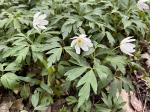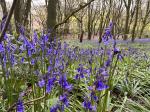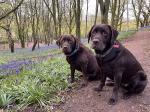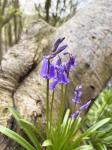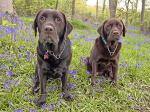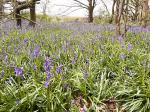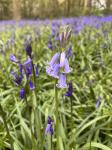Brayton Barff Through the Seasons.
Set in the Vale of York, South West of the market town of Selby and between the villages of Thorpe Willoughby and Brayton, lies Brayton Barff, a sandstone Hill approximately one hundred and fifty feet in height which was formed by glacial movement during the last Ice Age. It is a significant landmark in an otherwise flat landscape.
Today the site is primarily owned by Yorkshire Water with Selby District Council owning a small patch of the land adjacent to the A63 Selby bypass. A large underground reservoir occupies the centre of the site which delivers water to around 4.7 million customers throughout Yorkshire.
Within the Barff woodland over 40% of the trees are Sessile Oak which are generally found in semi natural woodlands in the north of the country. These trees are so called because its acorns are not held on stalks, like those of the English Oak (Pedunculate), but attached directly to the outer twigs. There are also several English Oak trees as well as some cross-hybrid oaks. These trees are known to support many species of flora and fauna, invertebrates, mosses, lichen and fungi.
During the Victorian times it is thought that the shipbuilders on the east coast would come over to the Barff for selected cuts of timber to build their sea going vessels.
The Barff also has a variety of other trees including Silver Birch, Beech, Sycamore, Holly, Rowan, Scots Pine, Alder, Hawthorne and European Larch. There are also several Yew, Willow, Hazel, Horse Chestnut and Wych Elm. As with similar woodlands there are a variety of bushes, including Honeysuckle, Elderberry, Gorse, Broom and Buddleia.
The history of Brayton Barff is quite vague, apparently during 1803 a beacon was lit on the Barff when the country was threatened with an invasion by Napoleon. In May 1935, to celebrate King George V's Silver Jubilee, a Bonfire was lit on the Barff as part of the celebrations.
Early issues of Ordnance Survey Maps dated 1903 clearly show a rifle range on the Barff, extending out to Mill Lane. During the 
Between 2001 – 2004 the A63 Selby bypass, 10km twin lane single carriageway was constructed which severed the South West corner of the Barff, adjacent to Selby Golf Course and resulted in a slight redesign of several holes on the golf course. Wooden fencing was erected as a result of this new road running alongside of the Barff and a footbridge constructed over the ‘new road’ following the line of the Bridal way which extends from Mill Lane. Around 2005/2006 a definite 2metre wide limestone aggregate footpath was laid forming a circular path around the outer edges of the woodland. This footpath is approximately 1.2 miles in length and takes about 30 minutes to circumnavigate at a leisurely pace.
In 2012 the Barff was declared an Ancient Oak Woodland and as such throughout 2012 and 2013 significant work had been carried out by the relevant agencies to cut and remove large swathes of non-native trees, creating at that time huge scars on the landscape. Some three years later the planting of the native trees have become well established and are flourishing. Ongoing maintenance work on the footpath around the bottom of the Barff was completed during the Summer of 2016.
A second phase of woodland maintenance commenced during the Autumn of 2019 with the removal of many old and diseased trees and the cutting back of the Gorse and Broom bushes, especially adjacent to the ‘bypass trail’, this work continued through till March 2020 with re planting continuing into April 2020.
Brayton Barff is a popular site for walkers and bird watchers alike and a path circling the outer perimeter of the Barff makes a pleasant thirty minute walk, giving views looking over towards Selby and the village of Brayton as well as the power stations of Drax and Eggborough..jpg)
For the early risers it is a great place to see some stunning sunrises over the villages of Brayton looking towards Drax Power Station, the same with the Sunsets looking over towards Eggborough and Monk Fryston.
The Barff changes with the Seasons and every visit can reveal something new, the woodland is a haven for wildlife. Records show that since 1982 one hundred and twelve species of bird have been seen in the woodland and at least 40 of those have bred here, including Tawny Owl, Buzzard, Green Woodpecker, Spotted Flycatcher, Goldcrest and Nuthatch to name just a few. On average over 70 species of bird are recorded each year. Further details of the bird life on the Barff can be found on the Brayton Barff Group Facebook page, especially the posts from Derek Cooper. Today ‘The Friends of Brayton Barff group’ led by Derek and a small team of volunteers help keep and maintain the cleanliness of the site as well as recording the wildlife and bird sightings.
The Barff is also home to fifteen different species of mammals, including Muntjac Deer, Pipistrelle Bat, Fox, and Field Vole.
Over eighty species of plant and wildflowers have been recorded, included Bee Orchid, Northern Marsh Orchid, Wood Anemone, Marsh Ragwort, Bluebell, White Bluebell, Bittersweet and Purple and White Foxgloves. Over twenty species of Butterfly have been recorded, including Marbled White, Brown Angus, Speckled Wood, Comma and Brimstone.
During the Autumnal months fungi thrives in this woodland environment, species including Fly Agaric, Beefsteak Tree Fungi, Chicken of the Wood, Sulphur Tufts, Stinkhorn, Ink cap, Puffballs and Hoof Bracket are just some of the many varieties that can be found here.
Click on the galleries shown below to expand the albums.
April 2023
Well, here we are at the end of April, the weather has been much cooler than normal, with several overnight frosts, heavy down pours and strong westerly winds, though for several days that changed to a north, north easterly wind, which brought a cold blast from the Artic. The morning temperatures on the Barff have varied from -2c with a touch of frost to 8c and averaged out over the month at 5c, the afternoon temperatures rising to between 12c to 15c. April’s rainfall has been above average for this time of year and we have had a fair share of rain on the Barff this month making some of the tracks quite slippery and muddy in places.
Spring has certainly arrived, the trees are coming out of their winter hibernation, all are in bud, Mountain Ash (Rowan) are shooting up all around the woodland, their tender, delicate leaves are opening up nicely, Alder, Sycamore, Maple and Birch trees are in leaf and beginning to green up. Several of the Elm trees along the Bypass trail are in flower. The lone Cherry tree is full of blossom at the moment. The Oak trees are several weeks behind and just coming into bud. What is interesting to look out for on several of them, are tiny ‘Oak Apples’, measuring between 2cm – 3cm in diameter, they occur at this time of year on both our native oak species, as well as other oak species, and can be found across the UK. They are not apples I might add, but are caused by the gall wasp. The wasp lays her eggs inside a dormant leaf bud, which then hatch in spring and start the process for the formation of galls. These galls tend to drop from the trees in June, when the larvae inside have matured and ready to fly.
Hawthorn is flourishing and in places coming into flower. Elderberry bushes have shot up since the beginning of April and in full leaf, many are now showing tiny clusters of Elderberries. Honeysuckle is thriving too, certainly amongst the trees on the top of the Barff, it will be several months though before they come into flower and fill the air with their sweet scent.
Brambles have come to life in earnest during April, their runners growing at an alarming rate and can leave a nasty scratch across the back of the hand for the unsuspecting walker, let alone tear your jacket or snag on your trousers.
The ferns are sprouting up all over the Barff, their fronds slowly uncurling, they thrive under the tree canopies and in several weeks’ time will cover and smother the Bluebells with their foliage. The Blackthorn blossom has been beautiful this year, especially along the Bypass trail. White Nettles and Red Dead Nettles are in flower and can be seen all over the woodland. Clumps of Herb Bennet/Wood Avens are beginning to flower, their delicate yellow 5 petalled florets providing an early source of nectar for our bees. It is always nice to see clusters of Wood Anemones appearing on the woodland floor, they too are beginning to flower, with six to seven large, white or purple-streaked 'petals' they seem to thrive in the dappled shade of the ancient woodlands. Lesser Celandine loves the damp woodland paths and tracks around the Barff, its yellow star like flowers bring some additional colour to the woodland at this time of year.
Creeping Buttercup is growing at an alarming rate, this British native perennial can be found all over the woodland and hugs the main perimeter footpath, it will be coming into flower anytime soon and will attracts flies, beetles and bees including honeybees. Its yellow flowers are about 2cm across,
The real star of the show in April though are the Bluebells, enchanting and iconic, Bluebells are a favourite with the fairies and a sure sign that spring has finally arrived. The first green shoots started to sprout through the woodland floor during late January, today, their violet bell-shaped flowers cover the easterly slopes of the Barff in a huge blue blanket, though they can be seen popping up in huge swathes all around the Barff. Their sweet-smelling flowers nod or droop to one side of the flowering stem. It is always a challenge to see who can spot the white ones.
The Birds have been much more vocal as the month progresses, I was concerned last month about the lack of sightings of Nuthatches around the Barff, well am pleased to say that I have seen at least two pairs recently, utilising the bird boxes around the woodland. Buzzard continues to prowl his patch and can be heard and seen most mornings calling and soaring high above the trees. Mistle Thrush continues to fill the air with a cacophony of bird song, I hear and see several most mornings on my daily ramble. Chiffchaffs seem to be increasing their numbers since the beginning of the month, their distinctive chiffchaff call quite noticeable at times. I always enjoy watching the Blackbirds going about their daily business, searching amongst the leaf litter in their quest for food.
Robin, Dunnock, Chaffinch, Blue & Great Tits regularly seem to escort Meg, Gracie and myself on our morning walk. Often when I veer off piste I can hear the delicate high pitched song of the Goldcrest.
Pheasant and Wood Pigeon seem to be quite scatty at the moment, either I or the dogs must startle them as we walk past, they fly away with lots of screeching and excessive flapping of wings before returning to their roost when we have passed them by.
The Greater Spotted Woodpeckers can be heard and seen most morning, busily drumming away on the trees either prizing a grub out of the bark or enlarging their nest hole.
Blackcaps seem to be slowly returning in numbers, their distinctive black heads can be seen and heard as you make your way round the main perimeter footpath.
Moles seem to be very active this month with their tell-tale mole hills popping up all over the place, be it alongside the perimeter footpath or high up on the top of the Barff’s summit. Apparently, they can tunnel up to 20 metres a day. For several days now I have walked along part of the service road on the Barff, up to the summit and noticed the road covered in worms crossing the road, hundreds of them, this ready food source must be what is bringing the moles out.
Bank Voles and Field Voles have been very active this month, with tiny holes appearing on the woodland floor, about one inch in diameter. They can produce three to six litters of up to seven young a year, and undergo population booms every few years. These increases don't last long, as they have short lifespans and fall prey to the Buzzard, Kestrel and Tawny Owls that frequent the Barff.
The fields surrounding the Barff are coming to life, I watched the Oil seed rape being planted last year and monitored its progress on a daily basis. It is currently in full flower, covering the ground with a huge yellow blanket, it is widely grown around the Selby area for the production of animal feed, vegetable oil for human consumption, and biodiesel, it is also shooting up along the grassy verges of Selby bypass adding a splash of colour to the road verges. It will be several more weeks till the yellow blossom dies back and the pods start to form and several more weeks till it is ready for harvesting. The carrot fields have just been covered with a layer of straw whilst several other fields have just been ploughed over ready to be planted with a potato crop.
I do appreciate the brighter mornings and look forward to the temperature warming up a little next month.
|

